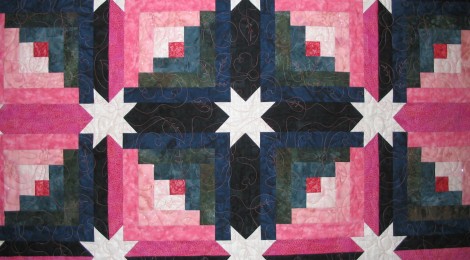
Log cabin quilts
One of the most beloved uses of the rectangle is in the log cabin block, where rectangles are several lengths are used, and a classic pattern develops if light and dark values are placed consistently on opposite sides of the block.
Here’s a simple log cabin block from the atomic quilting playset:
At the center are two squares, one of each value, light and dark. Typically in a log cabin quilt, the center square is red or a warm color, to indicate the hearth of a happy home. In the playset I just have light and darks so that’s what I used. Then the first rectangle added is a light rectangle that is two units long, the length of the two center squares. Then a dark two-unit rectangle is added, and then a three-unit dark rectangle. Then a three-unit light rectangle, followed by a four-unit light rectangle. The lights and darks are added in alternating pairs, as large as you want to make the basic block.
This yields a classic stair-step shape that can be laid out in a myriad of ways — in fact there are entire BOOKS written about log cabin quilts and their endless possibilities. (here’s a link to one of my favorites, Log Cabin ABC’s). I’ve also been pinning a little gallery of log cabin and rail fence quilts to look at over at pinterest.
Here’s a log cabin block I built from Cuisenaire rods, a wonderful math teaching toy that I used with my daughter when she was quite young. The rods vary from one unit to ten units long, a great way to familiarize yourself with the look of rectangles and how they’ll fit with their neighbors. But each length only comes in one color, so I couldn’t build a traditional block with alternating lights and darks. Still it’s kind of fun! Also I built the center from four one-unit squares, to show how you can enlarge the center and still fit the rectangles.
There’s a few classic layouts worth mentioning. The first is ‘barn raising’ which looks like a ‘trip around the world’ quilt — with similar concentric diamonds.
Here’s a slightly different layout, and the link goes to a pattern with lots of alternate layouts:
The PDF pattern you can download from the link above is pretty good — involves what I call the ‘prayer flag’ method of making log cabin blocks — but I think their version of the ‘barn raising’ layout isn’t quite correct. Or at least it’s not what other people call barn raising. That’s one of the interesting things about quilting, that the same thing can get called by several different names, depending on when the pattern emerged and which publication it appeared in.
As you can see, even with just a few examples, value is a really important aspect to quilting and to this block (and its layouts) in particular. Without the lights and darks placed carefully in each block, the overall patterns in each layout wouldn’t be visible — and what fun would that be! I’m one of those people who wants to see the results of all that hard work in piecing — so unless I’m working on a watercolor style quilt, where the piecing lines are supposed to fade away, I WANT to see all those piecing lines, and need enough contrast to do so.
Also it might occur to you as it has with me that value is one of those weirdly relative things. Other than white and black there are no inherent lights and darks, not really. Okay, well, yellow is inherently lighter than purple, but what I mean to say is that values are all relative to each other. Fabrics that are medium in value can be used as lights if used next to very dark fabrics and those same medium fabrics can behave as darks if placed next to pastels. So you might have to get used to the idea of values in a particular project being a function of how they relate to each other, not so much of what they are inherently.
With log cabin blocks, you can change the order of how you add the rectangles to the center, as well as where you place the lights and darks (or just similar or the same fabrics). Log cabin blocks can be clockwise or counterclockwise in the order you add pieces (and yes, if you mix them in the same project your layouts may look a little funky, and yes I know that from experience). If you add pieces top and bottom and then left and right, the block is then called courthouse steps and becomes a different animal all together (despite being essentially a log cabin quilt it doesn’t look like one any more).
See what I mean? You can see the centers — the lime green squares — and that will help you identify the block. Each block has four different colors of rectangle logs added to different sides of the lime green centers. The bold graphic result looks a bit like paper lanterns. And see how the scale of the different prints catches your eye and moves it around the quilt? If they were all the same scale it would make the quilt much more static.
Poke around the internet looking at log cabin and courthouse steps quilts, and you’re sure to find something interesting. Better yet try making one yourself!




